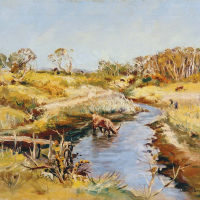226. ARTHUR BOYD

Those who have grown up in the peace and prosperity of the last sixty years find it hard to imagine the disruption and hardship caused by the six long years of World War Two. Even without the ever-present threat of death and injury to loved ones serving overseas, domestic life was a hard grind of shortages, rationing, a tight and constrained social order and an all-pervasive sense of unease and dislocation. Artists, especially those younger ones of an idealistic and modernist bent, expressed that unease in works that depicted a dystopian world of nightmare and social upheaval. Albert Tucker (1914-1999) imagined the dark streets inhabited by a debased humanity, Sidney Nolan (1917-1992) alternated between the desolate landscape of his forced exile in Dimboola and the frenetic hedonism of St Kilda, while their young friend Arthur Boyd produced harsh images of the crippled, the poor and insane; individuals who personified in their bleak lives the greater madness of a world at war.
Boyd left school at 14 to work, but he also took the opportunity to attend classes at the National Gallery School. On the death of his grandmother in 1937 he moved in with his grandfather, Arthur Merric Boyd (1862-1940) at the beachside village of Rosebud on the Mornington Peninsula. After three years working in a paint factory he was now able to paint full time and he learned a great deal about the painters craft from the older men and painted the surrounding countryside with insight and an ever-increasing technical skill. The coming of war in 1939 was an inevitable outcome after years of increasing pessimism and gloom. Arthur Boyd was just 19 when war broke out and, returning to the city, he saw the grimy inner suburban streets in a new light. He had been aware of the urban paintings of Danila Vassilieff (1897-1958), but in place of happy street urchins, Boyd saw desperate people, many of them victims of the previous war, struggling to make their way in a new and hostile world. Life was no longer a rural idyll, but there were compensations. His relationship with fellow artist Yvonne Lennie developed quickly and the two moved into their own home in Fitzroy.
Boyd was conscripted into the Army in 1941 and was drafted into the Survey Corps, the unit responsible for producing the maps and charts on which the conduct of the war so crucially depended. He was fortunate in being able to remain in Melbourne for the duration, with his primary task being the transport of materials and finished work between the city and the Survey Corps base near Bendigo. Long days on the road between the two centres gave him the chance to think, plan and even take time to produce drawings of the landscape. While his paintings of troubled life in the inner city might have become increasingly bleak, his war, like that of his friends Nolan and Tucker, was as benign as one might have hoped. Demobbed in 1944, the coming of peace a year later brought a return to normality and for Boyd, a challenging commission from his uncle Martin Boyd to paint a large mural at The Grange, the family home near Berwick. While that work, now only remaining in fragmented form, was an essay in spiritual and expressionist turmoil, he took the opportunity to reacquaint himself with the pleasures of plein-air painting. His 1946 Berwick Landscape is uplifting and joyous, a sunlit land at peace. A lone figure casts a line into the gliding stream, while cattle graze along its banks. But there is a hint too, perhaps, of the dark, recent past in the large beast that drinks at the creek. The horned beast was to become one of Boyds most enduring motifs and in this work it makes one of the first of its many appearances.
Gavin Fry BA (Hons), MA, M.Phil